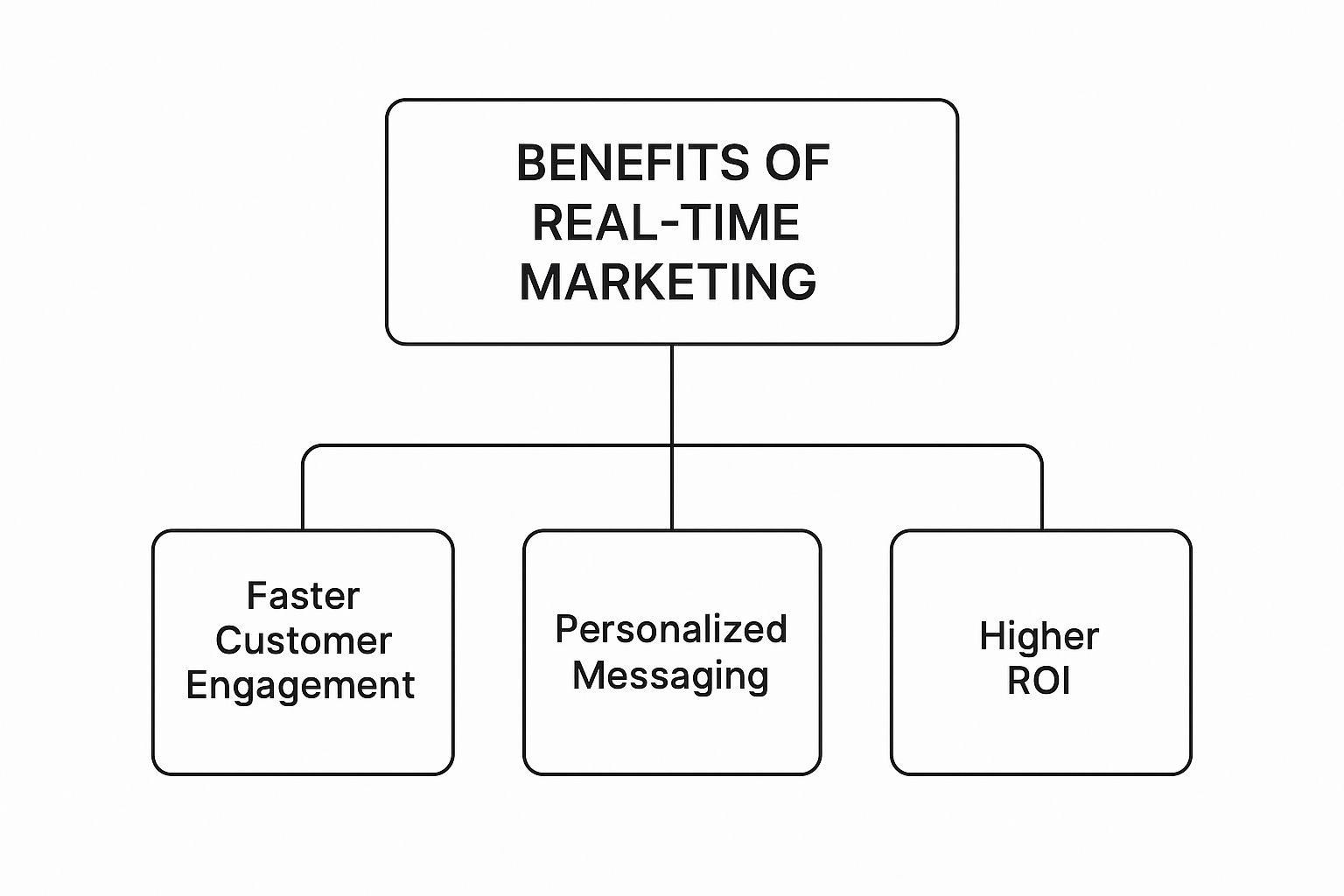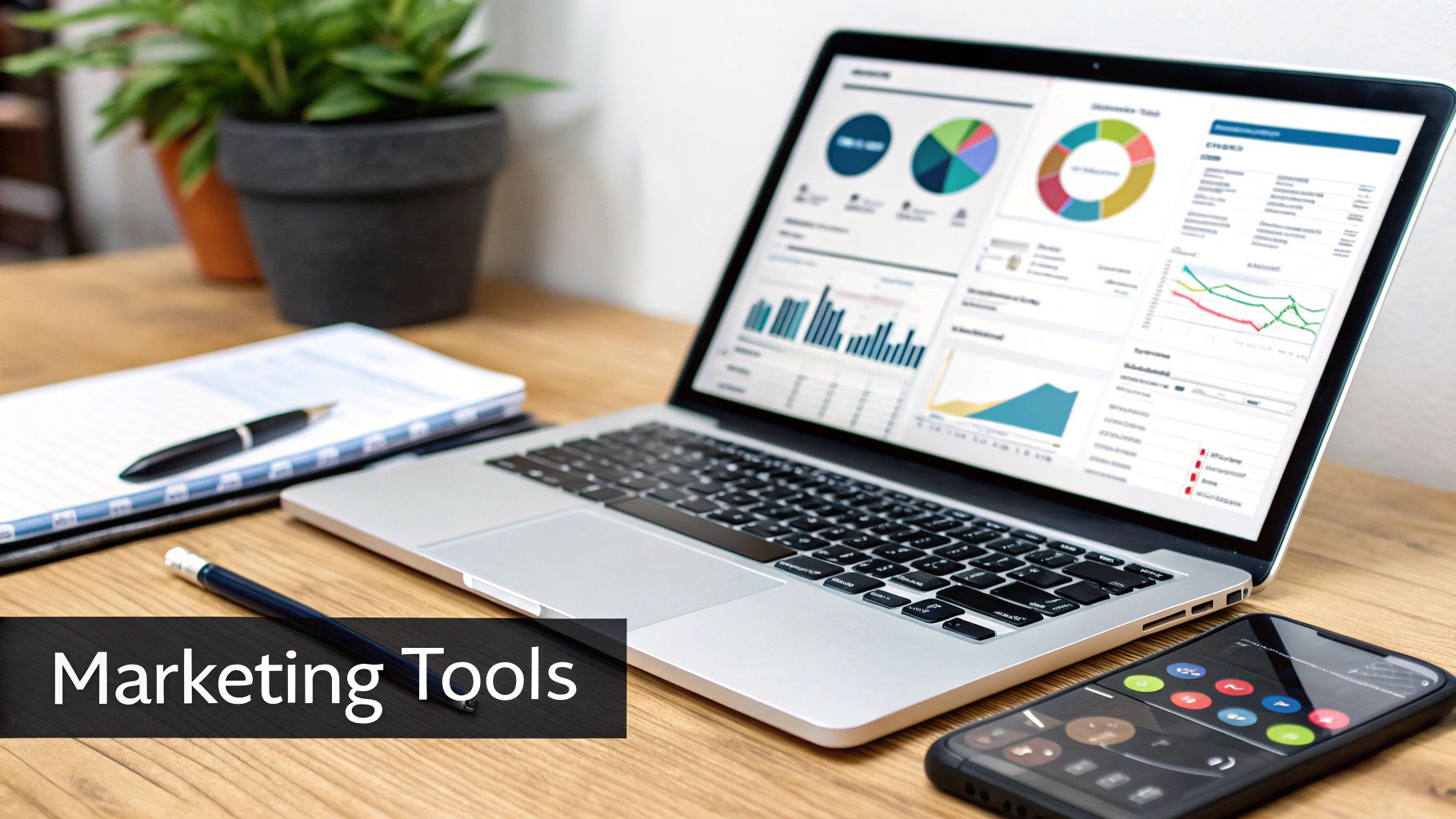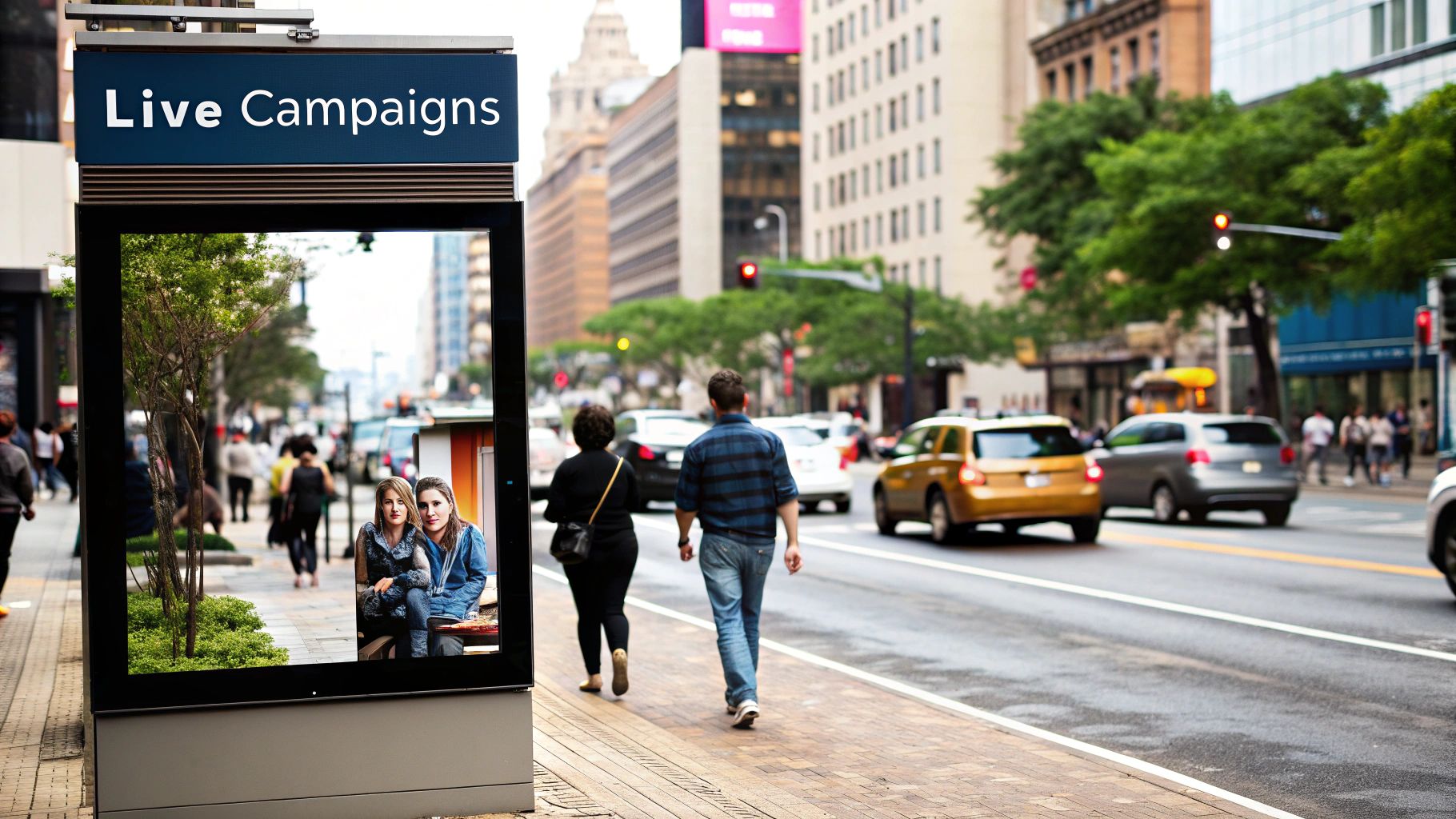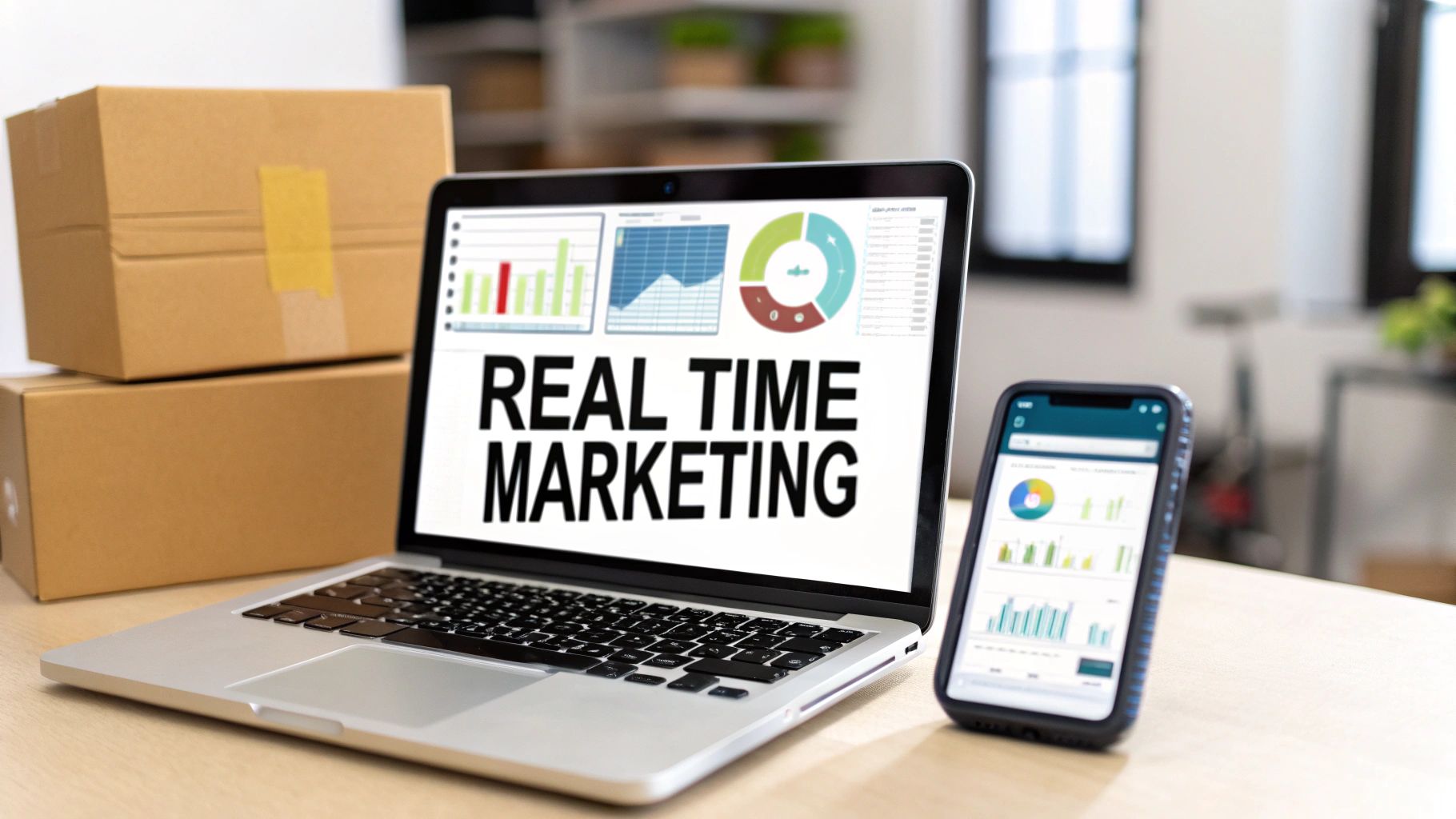Let's get right to it. You know that sinking feeling when a customer fills their cart with your products, gets all the way to checkout, and then... vanishes? Every e-commerce brand owner feels that pain. Real-time marketing is your secret weapon to stop that revenue bleed. It's about reacting to what your customers are doing right now with a perfectly timed, genuinely helpful message.
It’s not about that weekly newsletter you meticulously schedule. It’s about sending a message the instant a customer takes a specific action—like leaving that full cart behind or looking at the same product for the third time. In this guide, we'll show you exactly how to use real-time marketing to turn hesitant shoppers into loyal customers, using strategies we’ve perfected with over 500 Shopify stores.
What Does "Real-Time Marketing" Actually Mean for E-Commerce?
When you hear "real-time marketing," your mind might jump to a brand's clever tweet during the Super Bowl. While that's one flashy example, for your e-commerce store, the reality is much more practical and, frankly, more profitable. It’s about having an immediate, one-on-one conversation triggered by a specific action your customer just took.
From our experience, this is the most effective way to solve the biggest challenges e-commerce brands face: low margins, cart abandonment, and intense competition. Think of it like this: if a shopper looked lost in your physical store, a good sales assistant would walk over and ask if they need help. They wouldn't mail them a letter a week later. That’s the core of what real-time marketing is in the digital space.

The Shift From Broadcast to Conversation
For years, marketing was a one-way street. You craft a message, schedule an email blast or a social media post, and just hope it lands. It’s a classic “broadcast” model. A common mistake we see is brands still relying solely on this outdated approach.
Real-time marketing completely flips that script. Instead of shouting into the void, you're listening for customer signals and responding to them instantly, often using direct channels like WhatsApp. As an official Meta Business Partner, we've seen first-hand how powerful this conversational shift can be.
Why Immediacy Is Everything
In e-commerce, timing isn’t just important—it’s everything. A customer’s desire to buy is at its absolute peak the moment they’re browsing your site. Wait a few hours, and that impulse is gone. The moment is lost.
The big idea is simple: Engage customers when their interest is at its absolute peak. Don’t give them time to forget what was in their cart or get distracted by a competitor's ad.
This shift from scheduled campaigns to instant, triggered responses is the single biggest growth lever we've seen work for the 500+ Shopify stores we partner with. A well-timed WhatsApp message that lands seconds after they leave is infinitely more effective than a generic "did you forget something?" email that gets buried 24 hours later.
Traditional Marketing vs. Real-Time Marketing
The table below breaks down the fundamental differences between the planned, one-to-many approach of traditional marketing and the immediate, one-to-one nature of real-time marketing.
As you can see, it's a move from a carefully orchestrated monologue to a spontaneous, helpful conversation. Both have their place, but for driving immediate action and solving customer problems, real-time is in a league of its own.
The 3 Pillars of a High-Revenue Real-Time Strategy
After working with hundreds of e-commerce brands, we’ve seen what separates the winners from the rest. The strategy that consistently delivers the best results for our clients isn't based on luck; it's built on three core pillars that work in perfect harmony. Get these right, and you'll have an automated system that consistently drives revenue.
Think of it like building a high-performance engine. You need the right fuel (data), a smart ignition system (triggers), and a way to get that power to the wheels (your channel).
Pillar 1: Instant Data
The first and most critical pillar is Instant Data. This isn’t your quarterly sales report. It’s about knowing what’s happening on your store right this second.
- A customer just viewed the same pair of sneakers for the third time.
- A VIP just added an item to their cart that complements last month's purchase.
- A shopper just abandoned a cart worth over $200.
These are the golden moments. Tools like Kanal are built to capture these behavioral signals the instant they happen, giving you the real-time "fuel" you need to take action. Without instant data, you’re flying blind.
Pillar 2: Smart Triggers
Once you have the data, you need to do something with it. That's where Smart Triggers come in. These are simply the pre-defined "if/then" rules that turn raw data into a timely, automated, and helpful action.
- IF a cart is abandoned with items over $100... THEN wait 20 minutes and send a helpful WhatsApp message.
- IF a customer makes their second purchase... THEN wait 2 hours and send a thank you message inviting them to your VIP community.
- IF a product comes back in stock... THEN instantly notify everyone on the waitlist via WhatsApp.
A well-designed trigger from our abandoned cart recovery playbook can feel like you're personally reaching out to help a customer complete a purchase they were clearly interested in.
Pillar 3: An Immediate Channel
Finally, you need a way to deliver your message that ensures it will be seen now. This is the Immediate Channel. Sending a real-time trigger through a slow channel like email is like putting a rocket engine on a bicycle. The message gets buried, and the moment is gone.
This is exactly why WhatsApp is the ultimate channel for real-time marketing. With a 98% open rate, messages are almost always read within minutes. It’s the only channel that truly matches the immediacy of the customer's action, making sure your perfectly timed message lands with maximum impact.

When these elements are combined, the result is faster engagement, deeper personalization, and a much higher return on your marketing efforts.
Why Your E-Commerce Store Needs This Now
So, what does all this mean for your bottom line? This is where the theory of real-time marketing gets real, fast. For our clients, this isn't some "nice-to-have" strategy anymore; it's an absolute must for staying competitive.

The whole market is shifting. The technology that powers real-time marketing is exploding. A market report on real-time analytics found that the market grew by a whopping 22.63% in 2024. That’s a clear signal that brands are desperate for tools that let them act in the moment.
Slash Cart Abandonment Rates
Let's talk about the most painful leak in any e-commerce store: the abandoned cart. Sending a reminder email hours later doesn't cut it anymore. By then, your message is buried under a pile of other emails.
Imagine instead sending a WhatsApp message just 20-30 minutes after they leave. You’re catching them right in that moment of hesitation. It’s a personal, helpful nudge. We've seen clients recover up to 25% of otherwise lost carts with this single, timely move.
Boost Customer Lifetime Value (LTV)
The sale is just the beginning of the relationship. Real-time marketing is brilliant for building loyalty that lasts. Think about sending perfectly timed post-purchase messages—a quick "thank you," a request for a review, or a suggestion for a complementary product.
Key Takeaway: This is how you turn one-time buyers into loyal, repeat customers. These small, timely touchpoints make people feel valued, which is a direct line to increasing your Customer Lifetime Value (LTV)—the total revenue a single customer generates over their lifetime. We've seen clients increase their LTV by over 30% using these post-purchase flows.
If you want to get a tighter grip on this crucial metric, our guide on how to calculate customer lifetime value is a great place to start.
Improve Your Return on Ad Spend (ROAS)
You pour good money into ads to get people to your store. When that expensive traffic clicks away without buying, your Return on Ad Spend (ROAS) takes a direct hit.
Real-time marketing acts as your conversion safety net. By engaging those high-intent visitors while they're still on your site—or just moments after they’ve left—you give yourself a much better shot at closing the deal. This makes every ad dollar you spend work harder, maximizing your budget.
3 High-Impact Examples You Can Launch Today
Theory is great, but let's get actionable. After helping thousands of Shopify stores, we’ve pinpointed a few core automation flows that deliver results almost immediately. Here are three real-world examples you can build and launch right now, complete with the copy-paste templates we know convert.

1. The Cart Recovery Flow
If you set up only one flow, make it this one. It's your single best defense against the nearly 70% of carts that get abandoned, according to Baymard Institute data.
- The Goal: Nudge the customer to finish their purchase while it's still top-of-mind.
- The Trigger: A customer adds items to their cart but leaves your site without buying.
- Message 1 (Send after 30 minutes): A soft reminder.
Hey [FirstName], still thinking about it? 👀 Looks like you left a few great items in your cart. You can pick up right where you left off here: [CartLink]. Let us know if you have any questions! - Message 2 (Send after 4 hours): A helpful offer.
Hi [FirstName], just checking in to see if you had any trouble with checkout. Your cart is saved and waiting for you: [CartLink]. Here's 10% off to help you complete your order!
This sequence works because it feels helpful, not pushy. You’re using an immediate channel to solve a real-time problem, which is the core of what real-time marketing is.
2. The Post-Purchase Upsell
A customer’s trust in your brand is never higher than in the moments right after they've made a purchase. This is a golden opportunity.
- The Goal: Drive a repeat purchase by offering a complementary product.
- The Trigger: An order is marked as 'Delivered' in your Shopify admin.
- Message (Send 3 days after delivery):
Hi [FirstName]! Hope you're loving your new [ProductName]. A lot of our customers find it pairs perfectly with [ComplementaryProduct]. As a thank you, here’s 15% off if you'd like to try it out: [ProductLink]. Enjoy! ✨
This feels less like a sales pitch and more like a personalized recommendation. It shows you’re paying attention.
3. The 'Back in Stock' Alert
A sold-out item can be a huge frustration. Turn it into a sales opportunity. A WhatsApp notification is almost impossible to miss.
- The Goal: Instantly notify interested customers the moment their desired item is available, creating urgency.
- The Trigger: A product's inventory level changes from 0 to 1 or more.
- Message (Send instantly):
Great news, [FirstName]! 🎉 The [ProductName] you wanted is finally back in stock. These tend to sell out fast, so grab yours before it’s gone again: [ProductLink]. Don't miss out!
This approach not only recovers lost revenue but also creates an amazing customer experience.
The Most Common Mistakes to Avoid (And How to Fix Them)
Jumping into real-time marketing is exciting, but we've seen a few common mistakes derail great strategies. Learn from them so you can hit the ground running.
Mistake #1: Being Too Aggressive
The number one mistake is sending messages too quickly. Abandoning a cart and getting a text five seconds later doesn't feel helpful; it feels creepy.
- The Fix: Build in a thoughtful delay. For cart recovery, we've found that waiting 20-60 minutes is the sweet spot. You're going for a gentle nudge, not an aggressive shove.
Mistake #2: Forgetting to Personalize
A generic, one-size-fits-all message like "You forgot something!" feels robotic and lazy. The power is in making every interaction feel relevant.
- Use their name (
[FirstName]). - Reference the exact product (
[ProductName]). - Tailor the offer. A VIP customer should get a different message than a first-time visitor.
Mistake #3: Having No Clear Goal
Every message you send needs a clear, measurable purpose. Are you trying to recover a cart? Get a review? Drive a repeat purchase? Without a specific goal, you're just sending messages into the void.
- The Fix: Before you build any automation, define its objective. This is the only way you can track your success, measure your ROI, and make your strategy better over time. Our guide on how to master e-commerce funnel analysis can help you define these critical goals.
How to Build Your First Money-Making Flow in 15 Minutes
Alright, let's get our hands dirty. We’re going to set up the single most profitable automation any e-commerce store can have: the Abandoned Cart Recovery flow. Using a tool like Kanal, you can get this running in less time than it takes to brew a pot of coffee.
Here’s the step-by-step playbook:
- Connect Your Shopify Store: Install the Kanal app from the Shopify App Store. Our setup is no-code, so you can link your store in just a few clicks. No developers needed.
- Go to the Automation Builder: In your Kanal dashboard, find the "Automations" tab. This is your command center, and it’s loaded with pre-built templates for recovering abandoned carts.
- Set Your Trigger and Delay: Choose the "Abandoned Checkout" trigger. Pro-tip: set the time delay to 30 minutes. This buffer makes your message feel like a helpful nudge, not a pushy sales tactic.
- Personalize Your Message: Use the message editor to craft a friendly text. Instantly make it personal by adding tags like
[FirstName]and[CartLink]. - Activate Your Flow: Once you're happy with the message, hit "Activate." That's it! You've just deployed an automated system that works 24/7 to bring back lost sales.
A Few Common Questions Answered
When brands first hear about real-time marketing, a few questions always pop up. Let's tackle them head-on.
How is this different from email automation?
The answer is speed and relevance. A standard weekly email is planned automation—sent to a big list on a schedule. A WhatsApp message that lands 30 minutes after a customer abandoned their cart is a real-time, one-to-one response triggered by something they just did.
Is this expensive to set up?
Not at all. It’s one of the most cost-effective things you can do. Getting started with a tool like Kanal costs a fraction of what most brands pour into paid ads, but the ROI is often much higher because you're engaging high-intent customers.
Will this annoy my customers?
This is the most important question. When done right, it feels like helpful customer service, not an ad. Because you're reacting to a specific action, your message is timely and relevant—not random or intrusive. The goal is to add value, which is a key part of how to increase customer engagement without ever being pushy.
Start Converting More Customers Today
Real-time marketing isn't a futuristic concept; it's a practical, powerful strategy that you can implement today to stop losing sales and start building stronger customer relationships. By reacting to customer actions in the moment, you meet them exactly where they are with a message that's relevant, personal, and incredibly effective.
Key Takeaways:
- Real-time marketing is about reacting instantly to customer actions with personalized messages.
- It relies on three pillars: Instant Data, Smart Triggers, and an Immediate Channel like WhatsApp.
- You can use it to slash cart abandonment, boost customer LTV, and improve your ad spend.
Ready to build your own high-converting flows and see what real-time marketing can do for your revenue?
Install Kanal on your Shopify store today and start recovering lost sales.



